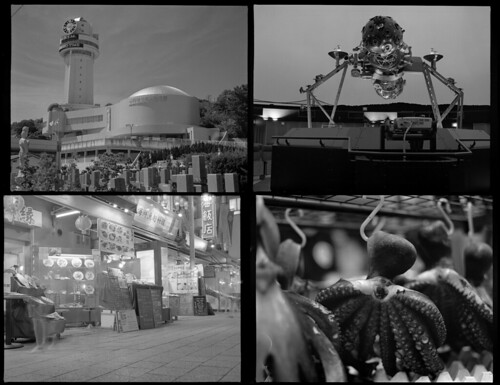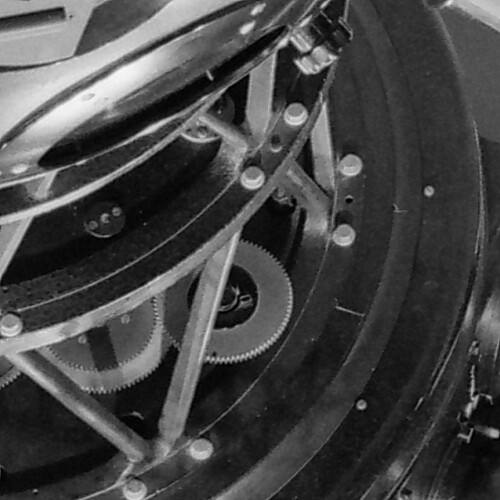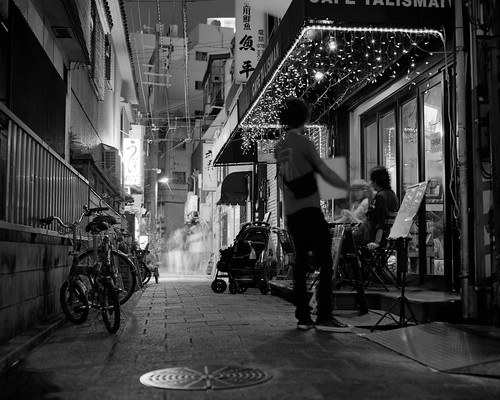My standard BW film is HP5, an iso 400 film that I often use at 800. Underexposed one stop like that it gives me fairly coarse grain and fairly low detail. Not that the lack of detail matters all that much; in medium format it still gives me more fine detail than my digital SLR, and plenty more than I need. I like the tonality, and at iso 800 there's enough speed to use it handheld in almost any situation.
Up until now, my normal 100-speed black and white film has been Fuji Acros. It has very fine grain and high resolution, but it tends to look flat, grey and washed out. When it's good it's really good (example). But when it's bad it's hopeless (example). I've shot several rolls of it, but I still don't have a handle on how to reliably avoid those flat, lifeless results.
Delta 100 really seems completely different. It has fine grain and resolution, just like Acros, but it has a much more pleasing contrast right from the start. The overall tonality is smooth and restful, and not at all flat. At the same time there's a sense of sharpness or "bite" to it that other films I've tried have lacked.
Here's four unedited shots with Delta 100, developed in D-76. The top two - an outdoor scene and an indoor one - are properly exposed. The bottom exposures are overexposed and underexposed respectively. I've set the black and white point, but they're otherwise unprocessed.
You can see the finished images in the previous post here.
The good: You get pleasant, clear images right out of the box. I shot this roll at iso 100, then developed it using D-76 (ND-76, actually) mixed 1:1 for 11 minutes; that's straight from the instructions. Scan the images with no brightness or gamma adjustment, set the black and white point (that is, make the darkest points black and the brightest points white) and you get results like above. No other film I've tried has given me something as pleasant with so little effort. You can see the finished versions in my previous post about Akashi here. Note how little I've had to edit them; I mainly just increased global contrast a bit and adjusted the brightness as needed. Sharpen a bit at the end. No heroics, no noise or grain reduction and no tricks with local contrast or anything.
Here's a sharpened crop of the planetarium from the original size image. The film holds a lot of detail, and the grain is hardly visible. The full image is 60Mp, but there's obviously not that much detail there. The scanner limits resolution to 30-35Mp or so; both the film and the lens is capable of more. As it is, if you see this on a normal monitor the whole image would be around 2 meters wide. Image resolution just isn't an issue for most of us any longer.
The bad: The downside of this clarity is that the film becomes fairly sensitive to exposure. The toe (the dark end of exposure) and the shoulder (the bright end) both seem fairly pronounced. So if you underexpose, most of the image will end up in the toe and become quite dark and moody. If you overexpose, much of the image will become washed-out.
This is exactly what's happened to the two bottom images in the unedited shots above. The octopus image is underexposed by about a stop, and the street scene is overexposed by perhaps two stops or so. Many films wouldn't bat an eye about such a small difference, but with this film it clearly matters. Good if you want this look on purpose of course, but if you don't it clearly pays to use a real light meter and make sure your exposure is right. I haven't tried playing with the processing, but I suspect the film is similarly sensitive to developing time and temperature as well.
Another negative is that, well, it is an iso 100 film. This is fairly slow. Anything less than daylight will need fairly fast lenses or a tripod. And if you use filters, not even sunlight may be enough - the planetarium above was shot with a red filter, and the slow shutter speed and an unstable vantage point (I was leaning halfway through a hedge) was enough to cause some real motion blur in the image.
A long exposure shot - five seconds or so - of a Kobe backstreet. That's the good thing with lugging a tripod around: long exposures become as easy to do as short ones, and you end up with much better detail and clarity than if you use a high-speed film or high-iso setting on your digital camera. Serious, professional people - people who know what they're talking about - often say that a tripod is the single most effective thing you can get for improving your images. I believe they're right.
I really like what I've seen of the film here, and I suspect it'd be great for doing landscapes and scenic shots, or long-exposure nighttime shots. You want lots of detail and your subject isn't going to be moving about a lot. I'm not sure how good this would be for street photography. At dusk or away from daylight people moving about will start to blur, and you can forget using this indoors without a tripod.
Delta 100 seems a very good fit for a high-quality medium-format (or large format I guess - I'd love to find out) camera like the Pentax 67. The optics can make good use of the high resolution and the lenses are fast enough to let you use the film handheld in daylight. For low light you need a tripod, but that's something you often use with this kind of camera anyway. It should be a good choice for a high-quality 35mm camera, for much the same reasons, and the fine grain and high resolution should help get the most out of the small film format. I should try it on the Minolta I have, or on the Canon SLR; a Leica or some other M-mount rangefinder should work very well too.
I wouldn't waste this film on cameras like the Voigtländer Bessa or Rollei 35. They're scale focusing cameras and best shot stopped down a fair bit. They'll usually be a bit out of focus, and the Voigtländer lens especially isn't all that sharp or contrasty. The high resolution of the film is wasted on them, and the low film speed is a real handicap as these cameras are best used handheld and stopped down to f/8 or less.
For street shooting and for old cameras with iffy optics I believe HP5 is a better choice. It's fast and it's easy to push with good results. But high-quality landscapes, daytime scenery or nighttime tripod shots with high-quality cameras is where I think Delta 100 should shine. We'll see if I still agree after I've used it for a while.




hello Janne!
ReplyDeleteyour blog is soo great!! I really envy you because you live in Japan*_*
Your photographs really touch my heart, they are so very very nice.
I will follow you.
one question: I wanna make a blog post about kobe and osaka, may I use some of your pictures in this post? of course I will put a link to your blog in my post.
again your blog is soooo beautiful*_*
have a nice day<3
Hi,
ReplyDeleteYou can probably use my images. The license I use lets you use them if
1) Attribution: you give me credit and a link to the original image;
2) Non<commercial: you're using them non-commercially (so a personal blog is OK, a company blog is not);
3) Share alike: if you license your things in a similar manner - that is, your text on those blog posts is also licensed to allow anybody to reuse it for (at least) non-commercial use with attribution back to you. The idea is that I allow others to use my stuff freely, but in return I ask that others do the same.
So, if you license your blog post like that then it's fine. If not then it's not.